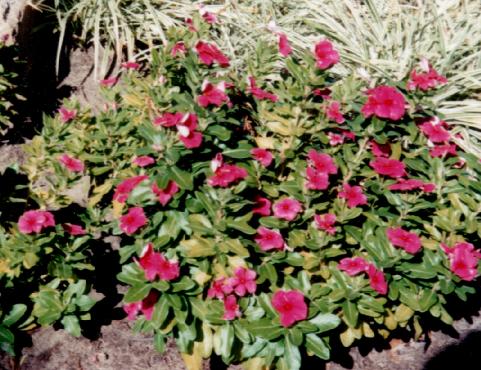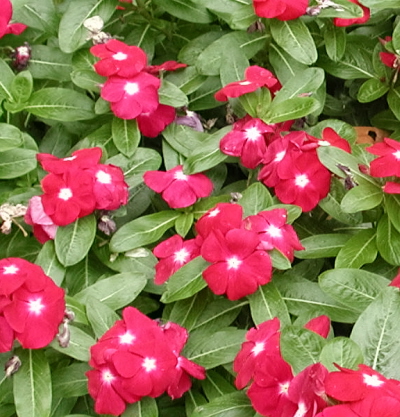

| Vinca: really easy
An easy one, even for beginners, Vinca is
a common but classy looking annual that is commonly available from garden
centers in six packs in the spring. It is slow to germinate and takes three months to grow large enough to transplant.
The plant known as annual vinca or periwinkle, scientific name Catharanthus roseus,
unfortunately has the same common name as two other plants with different characteristics but with similar leaves and flowers, scientific names Vinca major and Vinca minor. Both are perennial vines used as groundcovers.
Annual vinca is a small bush-like plant 10 to 18 inches tall with multiple stems. It is perennial only in regions where there is no frost. Since it originated on the tropical island of Madagascar, it is sometimes called Madagascar Periwinkle.
Coolest colors
The blooms, about one and half inches across, are numerous and have five petals. They come in cool dayglow colors especially purple, red, pink, white, and orange. Blooms often have central "eyes" of white or contrasting color.
The glossy green oval leaves are an asset to its appearance.
Vinca tolerates full sun and heat very well, but will grow with a fair amount of shade too. Three hours of sun is sufficient. Vinca needs
little care other than watering. Rich, well-drained soil is best for planting, but average soil will do. Light feedings of liquid fertilizer or manure tea once a month is helpful. The plants grow upright at first, then become bushier, and it generally stays compact and tidy. It does not need dead heading. Vinca is moderately drought tolerant.
The plants should be planted a foot apart along the front or middle of the flower bed. Diseases and pests are uncommon though aphids, spider mites, white flies, slugs, and snails occasionally feed on them. Diseases are not common but stem rot sometimes is a problem. Remove affected plants. Larger pests such as rabbits and deer avoid eating vinca.
 Periwinkle is often grown in pots and hanging baskets. Blooms will continue until frost. Pruning is usually unneeded, but do remove any stems or sections that are diseased or damaged.
Periwinkle is often grown in pots and hanging baskets. Blooms will continue until frost. Pruning is usually unneeded, but do remove any stems or sections that are diseased or damaged.
An interesting side to Madagascar periwinkle is its medical uses. Chemicals from the plant (Catharanthus roseus) prevent the division of cells and are used to treat leukaemia. One internet source also claims it is used in India to treat wasp stings. All parts of vinca plants are poisonoius if eaten.
Scientific Name: Catharanthus roseus
Cultivated Varieties Include:
The 'Victory' series has intense, clear colors and a compact growing habit. The 'Heat-Wave' series and the cultivar 'Santa Fe' appear to be more tolerant of warm, dry weather than other cultivars and may be a better selection for southern growers. The series 'Tropicana' and 'Pacifica' perform well in seemingly excessive heat and humidity, and are fast becoming a favorite. The 'Mediterranean' series is another good series that is fairly vigorous and performs well in very warm conditions. 'Morning Mist' is a border type vinca with remarkable tolerance to heat, and 'Parasol' is an All American Selection winner that has excellent branching and heat tolerance. The 'Cooler' series performs exceptionally well under relatively cool conditions, making it a well-suited crop in the western United States.
Magic Carpet, 'Cooler Series', 'Nirvana series', 'Pretty Series'

|


